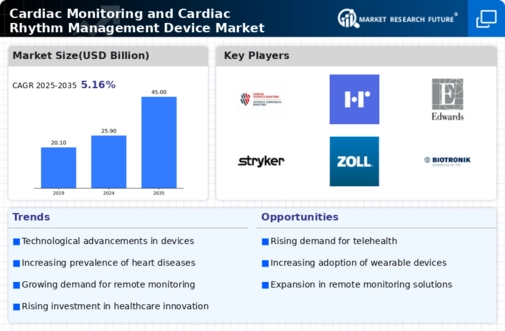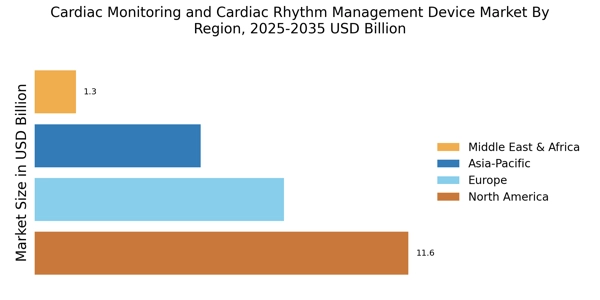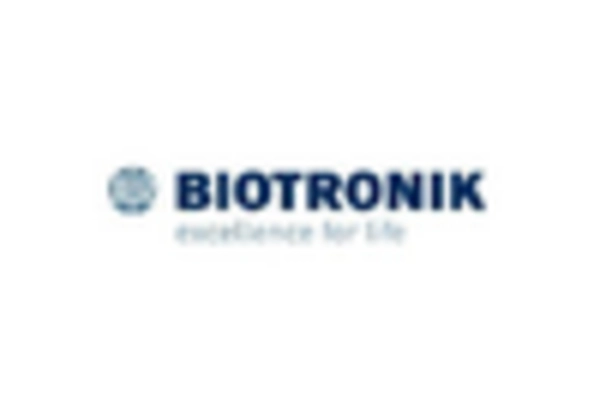Regulatory Support for Cardiac Devices
Regulatory frameworks are increasingly supportive of innovations in the Cardiac Monitoring and Cardiac Rhythm Management Device Market. Regulatory bodies are streamlining approval processes for new cardiac devices, which encourages manufacturers to invest in research and development. This supportive environment fosters innovation and accelerates the introduction of advanced monitoring solutions to the market. Additionally, regulatory incentives for the adoption of digital health technologies are likely to enhance the availability of cutting-edge cardiac devices. As regulations evolve to accommodate new technologies, manufacturers are better positioned to meet the growing demand for effective cardiac management solutions. This regulatory support is expected to play a vital role in shaping the future landscape of the cardiac device market, facilitating the development of safer and more effective products.
Increasing Prevalence of Cardiac Diseases
The rising incidence of cardiac diseases is a primary driver for the Cardiac Monitoring and Cardiac Rhythm Management Device Market. According to recent statistics, cardiovascular diseases account for a substantial portion of global mortality rates, prompting a heightened demand for effective monitoring and management solutions. As populations age and lifestyle-related health issues become more prevalent, the need for advanced cardiac devices intensifies. This trend is further supported by the increasing awareness of heart health, leading to more individuals seeking preventive measures and regular monitoring. Consequently, healthcare providers are investing in innovative cardiac monitoring technologies to enhance patient outcomes, thereby propelling market growth. The integration of these devices into routine healthcare practices is likely to become more commonplace, reflecting a shift towards proactive cardiac care.
Rising Awareness of Preventive Healthcare
The increasing awareness of preventive healthcare is a significant driver for the Cardiac Monitoring and Cardiac Rhythm Management Device Market. As individuals become more informed about the importance of heart health, there is a growing inclination towards regular monitoring and early detection of cardiac issues. Educational campaigns and health initiatives are promoting the benefits of proactive cardiac care, leading to higher adoption rates of monitoring devices. This trend is particularly evident among younger populations who are increasingly prioritizing their health and wellness. Market data suggests that the demand for preventive cardiac devices is on the rise, as consumers seek tools that empower them to take charge of their health. This shift towards preventive measures is likely to sustain market growth, as more individuals recognize the value of monitoring their cardiac health.
Growing Demand for Remote Patient Monitoring
The shift towards remote patient monitoring is significantly influencing the Cardiac Monitoring and Cardiac Rhythm Management Device Market. With the increasing emphasis on patient-centered care, healthcare providers are adopting remote monitoring solutions to enhance patient engagement and adherence to treatment plans. This trend is particularly relevant in managing chronic cardiac conditions, where continuous monitoring is essential. The convenience of remote monitoring allows patients to receive timely feedback and interventions without frequent hospital visits, thereby improving their quality of life. Market data indicates that the remote patient monitoring segment is expected to grow substantially, driven by advancements in telehealth technologies and the rising acceptance of digital health solutions. This shift not only benefits patients but also alleviates the burden on healthcare systems, making it a pivotal driver for market expansion.
Technological Innovations in Cardiac Devices
Technological advancements play a crucial role in shaping the Cardiac Monitoring and Cardiac Rhythm Management Device Market. Innovations such as wearable devices, remote monitoring systems, and advanced diagnostic tools are revolutionizing how cardiac health is managed. For instance, the introduction of smartwatches with ECG capabilities has made it easier for individuals to monitor their heart rhythms in real-time. Furthermore, the development of AI-driven analytics in cardiac devices enhances the accuracy of diagnostics and patient monitoring. These innovations not only improve patient engagement but also facilitate timely interventions, which are essential for managing cardiac conditions effectively. As technology continues to evolve, the market is expected to witness a surge in demand for sophisticated cardiac monitoring solutions that offer enhanced functionality and user-friendliness.


















Leave a Comment